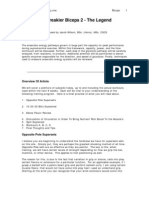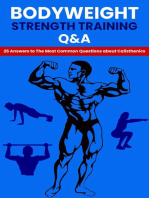Question of Strength 32
Question of Strength 32
Uploaded by
Dave JohnCopyright:
Available Formats
Question of Strength 32
Question of Strength 32
Uploaded by
Dave JohnCopyright
Available Formats
Share this document
Did you find this document useful?
Is this content inappropriate?
Copyright:
Available Formats
Question of Strength 32
Question of Strength 32
Uploaded by
Dave JohnCopyright:
Available Formats
QUESTION OF STRENGTH
32
by Charles Poliquin | May 12, 2000|Leave a Comment
BODYBUILDING, POWERLIFTING &
Tags
STRENGTH, QUESTION OF
STRENGTH, TRAINING
Q: What type of diet would you recommend while using your 1-6-1
training program? In general, what would you suggest for anyone
whose primary goal is to build strength?
A: In a nutshell, when interested in increasing your level of maximal
strength (regardless of whether you're doing the 1-6-1 program or
some other routine geared toward increasing strength), I find that
supplements actually play a bigger part than diet. This, of course, is
assuming that you're eating a diet that's more well-balanced than
that eaten by the average guest on the Jerry Springer show.
Additionally, diets are very individual specific, and trying to prescribe
a universal strength-building diet is risky. The key thing to keep in
mind, however, in eating for maximal strength gains is focus, and
anything that dulls your focus should immediately be kicked out of
your diet with the deftness of an Irish barkeeper throwing out an
unruly drunk. Personally, I have to abstain from carbs until the
workout is over, even the low glycemic index ones. Contrast that
with pro bodybuilder Milos Sarcev, however, who can ingest enough
pasta to save a small African nation from starvation and still have a
great workout. Compounds that I have found to help increase
strength:
Power Drive, not to exceed the recommended dosage
Acetyl-l-carnitine, 3-7 grams per day
Glutamine, 30-70 grams per day
Branched-chain aminos/glutamine, taken while training, like
Beverly International's Muscularity (800-781-3475)
Methoxy-7, four tablespoons per day (I particularly like it for
athletes who need to compete in weight classes, as it also
allows them to lose bodyfat)
Ribose/creatine combo, four servings per day
Sufficient protein, two grams per pound of bodyweight (most
individuals will need to use liquid meals to achieve this target)
Plenty of smart fats like CLA and fish oils
Certain forms of tocotrienols in high dosages (they also
dramatically reduce cholesterol)
Various herbal preparations (this goes beyond the scope of
this column, I enlist the help of a naturopath trained in
herbology)
I'm not suggesting that you take all of the previous compounds at
once. But I do recommend that you experiment with some of them,
either alone or in combination, and find what works best for you.
Q: What do you think of "jump squats"? If you like them, how would
you recommend incorporating them into a program?
A: They're excellent for improving vertical-jump ability and
shortening the "stance phase" in sprinting (the time you make
contact with the ground; the shorter it is, the faster you're running).
The problem most people experience with this exercise is that they
use loads that far exceed their stretch-shortening cycle capabilities.
In other words, they spend way too much time on the ground, which
negates the positive transfer of this exercise. Obviously, you can't
load a bank vault on your back and expect to spring up with any
degree of explosive power.
Studies on various track and field groups would tend to suggest that
an athlete never use more than 40% of his or her best power snatch
for this exercise. I normally use five to ten sets of six to ten reps on
this exercise. The ground contact time has to be kept to a minimum.
If the weight you're using doesn't allow you to immediately explode
back up, your vertical jump is doomed to stay in the modest range.
You'll be able to leap over any two-by-fours that bar your way with
amazing deftness, but not much beyond that.
Q: Hey, Charles, I want traps like WCW wrestler Goldberg. I've
never heard of a "trap specialization" program. Should I just do lots
of shrugs and upright rows, or is there something better? Thanks for
the advice! Think you could kick Goldberg's ass, shorty?
A: Yes, you can do a specialized trap routine. This muscle normally
has a very rapid growth response, so much so that if you can't grow
traps, you're truly destined for geekhood.
Submission fighters use plenty of trap work to improve their specific
skills. Ultimate Fighting championship winner Ken Shamrock has a
set of traps that most pro bodybuilders would envy.
Powerlifters get their trap development from years of deadlifting
while the Olympic lifters get them simply from the Olympic lifts and
their derivatives. In fact, British powerlifter and World Record Holder
Vanessa Gibson has trap development that makes Goldberg look
cachectic. Her breasts are nicer, too, but that's beside the point.
I'd rank the power snatch as the top trap builder. Then, power
cleans and the different forms of shrugs. Here's a good 12- workout
trap cycle that should pack the meat on:
WORKOUTS 1-6 (WORKING TRAPS EVERY FIFTH DAY)
A. Power snatch from mid-thigh
Five sets of five to six reps on a 10X0 tempo, resting for three
minutes between sets.
Editor's note: The numbers in the tempo refer to how many
seconds it should take you to do the rep, with the first number
referring to the lowering portion of the rep and the second
number referring to the pause, if any, between lowering and
lifting. The third number denotes how long it should take you to
lift the weight (an "X" denoting explosive speed) while the last
number is the interim between lifting and lowering, if any.
B. Trap tri-set
Seated dumbbell shrugs, three sets of six to eight reps on a
2022 tempo
Rest for ten seconds
Standing barbell shrugs, three sets of 10-12 reps on a 1110
tempo (note a pause at the top of the movement)
Rest for ten seconds
Upright cable rows, three sets of 12-15 reps on a 2010 tempo
Rest for two minutes
Repeat all steps two more times
WORKOUTS 7-12
A. Power cleans from blocks
Ten sets of two to three reps on a 10X0 tempo, resting for
three minutes between sets
B. Single-arm dumbbell shrugs
Five sets of six to eight reps on a 2011 tempo, resting for three
minutes between sets (single-arm shrugs allows for a greater
range of motion)
Supplemental neck work is also indicated if you want to further
thicken the neck. Regarding kicking Goldberg's ass, I don't mind
fighting out of my weight class, but fighting out of my species is a
completely different story.
Q: Could you give us some general guidelines as to how an athlete
should train in-season as opposed to off-season? I know that can
get complicated and can be sport-specific, but are there any "rules
of thumb" to use as guidelines?
A: Here are some rules of thumb regarding in-season strength
training: there's no need for so-called specific work. You're already
doing plenty of that on the field, or on the ice. I know of one team
who chose to do "sport-specific training" during the season. Eleven
out of fourteen athletes developed patellar tendonitis in a short
amount of time.
It takes very little work to maintain strength, particularly if the sport
itself offers a lot of external resistance. For example, we found with
our alpine ski team that training quads once every 21 days was
sufficient to keep 90% of the previously acquired gains in the so-
called off-season.
I feel that an athlete should be more interested in staying as healthy
as possible in the off season. Again, using an alpine skiing example,
we found that training the hamstrings once every five to seven days
was critical in keeping down the incidence of knee injuries.
My general guidelines include the following: Losing muscle mass
precipitates maximal strength losses. Therefore, adequate attention
should be given to preserving as much muscle mass as possible.
This is best accomplished by doing one to two sets of six to ten RM
every seven to ten days. The workouts should be very short, i.e. 20-
40 minutes.
An approach that works well for maintenance is the "one exercise,
post-technical session" approach. Judokas and submission fighters
use it with great results. For example, on Monday after mat practice,
they may do sets of chins. On Tuesdays they'll squat. Wednesdays
are devoted to incline presses. Thursday is Miller time. You get the
picture. On average, they'll knock off to to five sets of the exercise
of the day.
Additionally, the more muscle one has, the easier it is to maintain
maximal strength. Therefore, smaller individuals may need to
strength train more often during the competitive period. For
example, Chris Pronger of the St. Louis Blues, one of the top
defensemen in the league (albeit a smaller individual), has a very
strict training regimen during the season, and yet he plays up to 40
minutes a game. By contrast, Jim McKenzie of the Washington
Capitals and Rich Pilon of the New York Rangers, both very
muscular individuals, get by with little in-season work.
Q: Okay, fine, squats are the king of leg exercises. The problem is
that I'm bored of squatting. Could you give me a quad-dominant
exercise to break the monotony that's, well, almost as good as the
squat?
A: Sorry, but I'm sure that my colleagues Al Vermeil and Ian King
will agree with this statement: there are no substitutes for the
squat. The squat exercise not only recruits a great deal of motor
units, but it also generates an unequaled hormonal response which
puts you into anabolic drive. And it allows you to get close to the
floor to see if there are any dust bunnies under the squat rack. No
amount of leg presses or lunges can substitute for the back squat.
The closest alternative would be the trap bar deadlift, performed on
the podium. This exercise can provide a welcome break from the
squat. If you're going to do more than three reps per set, however,
then I'd recommend you use straps so that your isometric-strength
endurance does not become a limiting factor in applying overload
on those muscles. Make sure to keep the upper arms relaxed
throughout the exercise and to initiate the movement by driving with
the legs, not the lower back.
After a three-week cycle on this form of deadlift, you can return to
the squat with renewed interest, and most likely set yourself up to
achieve new PR levels in a short time. You can add spice to your
squat life (in addition to more weight) by employing devices like the
eccentric hooks called Power Recruits (call 814-378-7108) and the
Full-Speed device.
And, if you're still bored, try this method. The next time you squat,
and you're coming up from the bottom position, pause three times
for eight seconds each time during the concentric range of your last
repetition. That'll have you cursing me out, for sure.
You might also like
- Charles Poliquin - Simpleton Guide To Poliquin Training Principles 1Document8 pagesCharles Poliquin - Simpleton Guide To Poliquin Training Principles 1Alen_D100% (9)
- Racked and Loaded 2019Document55 pagesRacked and Loaded 2019Vikas Reddy100% (1)
- Ef73152bedf3ae PDFDocument2 pagesEf73152bedf3ae PDFMouloud ZéMaNo ratings yet
- 10 Essentials For Training Power AthletesDocument9 pages10 Essentials For Training Power Athletesinstantoffense100% (2)
- Dorian Yates Workout RoutinesDocument8 pagesDorian Yates Workout RoutinesMiguel Pinneaple100% (10)
- Q A Charles PoliquinDocument106 pagesQ A Charles PoliquinMoosa Fadhel100% (3)
- Book of Programmes for the Team Sport Athlete; Size & StrengthFrom EverandBook of Programmes for the Team Sport Athlete; Size & StrengthNo ratings yet
- Question of Strength 27Document9 pagesQuestion of Strength 27Dave JohnNo ratings yet
- BODYBUILDING POLIQUIN, Charles - Guide To Charles Poliquin's Training PrinciplesDocument5 pagesBODYBUILDING POLIQUIN, Charles - Guide To Charles Poliquin's Training Principlesbasura357magnum100% (1)
- Question of Strength 26Document9 pagesQuestion of Strength 26Dave JohnNo ratings yet
- Question of Strength 24Document9 pagesQuestion of Strength 24Dave JohnNo ratings yet
- 10 X 10 PoliquinDocument3 pages10 X 10 PoliquinSergio Ramos Ustio100% (2)
- Question of Strength 17Document9 pagesQuestion of Strength 17Dave JohnNo ratings yet
- Grease The GrooveDocument4 pagesGrease The GrooveKyle Randolph100% (2)
- A Warm Up Can Undoubtedly Be Advantageous If Done ProperlyDocument7 pagesA Warm Up Can Undoubtedly Be Advantageous If Done ProperlyTonyNo ratings yet
- Question of Strength 43Document26 pagesQuestion of Strength 43Dave JohnNo ratings yet
- Grip Training For The DeadliftDocument12 pagesGrip Training For The DeadliftÒó Reverse100% (2)
- Grease The Groove For StrengthDocument4 pagesGrease The Groove For StrengthVan KochkarianNo ratings yet
- Burn Reps For Anabolic GrowthDocument6 pagesBurn Reps For Anabolic Growthaligaram100% (2)
- Question of Strength 39Document19 pagesQuestion of Strength 39Dave JohnNo ratings yet
- Question of Strength 23Document7 pagesQuestion of Strength 23Dave JohnNo ratings yet
- Question of Strength 20Document6 pagesQuestion of Strength 20Dave JohnNo ratings yet
- Question of Strength 37Document19 pagesQuestion of Strength 37Dave JohnNo ratings yet
- Racked and Loaded 2023 RevDocument55 pagesRacked and Loaded 2023 RevRaúl Martínez TelloNo ratings yet
- Question of Strength 21Document7 pagesQuestion of Strength 21Dave JohnNo ratings yet
- Supersets For Super ResultsDocument11 pagesSupersets For Super ResultsaligaramNo ratings yet
- Grip Andy BoltonDocument4 pagesGrip Andy BoltonFilipe Marques100% (1)
- Question of Strength 19Document8 pagesQuestion of Strength 19Dave JohnNo ratings yet
- 8 Weeks To Bigger Biceps 2Document10 pages8 Weeks To Bigger Biceps 2wxman6877No ratings yet
- T NATION - Circuit Training For Combat AthletesDocument4 pagesT NATION - Circuit Training For Combat AthletesturbobrikNo ratings yet
- Question of Strength 3Document7 pagesQuestion of Strength 3Dave JohnNo ratings yet
- Question of Strength 28Document12 pagesQuestion of Strength 28Dave JohnNo ratings yet
- ThibarmyDocument7 pagesThibarmyKomkor GuyNo ratings yet
- Question of Strength 46Document17 pagesQuestion of Strength 46Dave JohnNo ratings yet
- Question of Strength 45Document28 pagesQuestion of Strength 45Dave JohnNo ratings yet
- Question of Strength 30Document7 pagesQuestion of Strength 30Dave JohnNo ratings yet
- Train To Success, Not Failure: Anti-Glycolytic Training (AGT)Document7 pagesTrain To Success, Not Failure: Anti-Glycolytic Training (AGT)Marko Štambuk100% (1)
- Ajac Strength StandardsDocument5 pagesAjac Strength StandardsGareth JordanNo ratings yet
- Question of Strength 36Document13 pagesQuestion of Strength 36Dave JohnNo ratings yet
- Question of Strength 31Document10 pagesQuestion of Strength 31Dave JohnNo ratings yet
- Pavel IntDocument11 pagesPavel Inttjoodkeedee100% (1)
- 3 Day Hollywood Body PDFDocument14 pages3 Day Hollywood Body PDFSammi TovarNo ratings yet
- Warrior Workouts, Volume 3: 100 of the All-Time Greatest Military and Tactical Fitness WorkoutsFrom EverandWarrior Workouts, Volume 3: 100 of the All-Time Greatest Military and Tactical Fitness WorkoutsNo ratings yet
- 3 Day Routine: Lunes: Pecho Y EspaldaDocument6 pages3 Day Routine: Lunes: Pecho Y EspaldaRafa MeloNo ratings yet
- Bodybuilding - The Rock Hard Challenge (Month 2 Training)Document10 pagesBodybuilding - The Rock Hard Challenge (Month 2 Training)jwarswolvesNo ratings yet
- Design Your Workout.01 PDFDocument15 pagesDesign Your Workout.01 PDFRaja100% (1)
- Question of Strength 25Document7 pagesQuestion of Strength 25Dave JohnNo ratings yet
- Advanced+Training+Variables+BluePrintDocument15 pagesAdvanced+Training+Variables+BluePrintKosta MilovanovicNo ratings yet
- THE BEST COMPREHENSIVE TRAINING METHOD IN HISTORYDocument7 pagesTHE BEST COMPREHENSIVE TRAINING METHOD IN HISTORYScribdTranslationsNo ratings yet
- Principles of Mass Construction by Dorian YatesDocument7 pagesPrinciples of Mass Construction by Dorian YatesCLAVDIVS100% (3)
- The Naked WarriorDocument16 pagesThe Naked WarriororangNo ratings yet
- Training Methods On Trial - Breathing Squats - Christian Thibaudeau Coaching - Forums - T NationDocument20 pagesTraining Methods On Trial - Breathing Squats - Christian Thibaudeau Coaching - Forums - T NationVladimir OlefirenkoNo ratings yet
- Basics of Resistance Training The Fastest And Safest Way To Increase Your StrengthFrom EverandBasics of Resistance Training The Fastest And Safest Way To Increase Your StrengthNo ratings yet
- Warrior Workouts, Volume 1: Over 100 of the Most Challenging Workouts Ever CreatedFrom EverandWarrior Workouts, Volume 1: Over 100 of the Most Challenging Workouts Ever CreatedNo ratings yet
- More Strength, Less Muscle Size: 21 Essential Tips to Boost Muscle Power Without Bulking UpFrom EverandMore Strength, Less Muscle Size: 21 Essential Tips to Boost Muscle Power Without Bulking UpNo ratings yet
- Bodyweight Strength Training Q&A: 26 Answers To The Most Common Questions About CalisthenicsFrom EverandBodyweight Strength Training Q&A: 26 Answers To The Most Common Questions About CalisthenicsNo ratings yet
- Doug Briggs Strength, Speed, & Agility Book 2016: Get Strong, Get Fast, And Get AgileFrom EverandDoug Briggs Strength, Speed, & Agility Book 2016: Get Strong, Get Fast, And Get AgileNo ratings yet
- Tabata Workout Handbook, Volume 2: More than 100 All-New, High Intensity Interval Training Workouts (HIIT) for All Fitness LevelsFrom EverandTabata Workout Handbook, Volume 2: More than 100 All-New, High Intensity Interval Training Workouts (HIIT) for All Fitness LevelsNo ratings yet
- 101 Best Pyramid Training Workouts: The Ultimate Challenge Workout CollectionFrom Everand101 Best Pyramid Training Workouts: The Ultimate Challenge Workout CollectionNo ratings yet
- 10 Resume TipsDocument1 page10 Resume TipsDave JohnNo ratings yet
- Question of Strength 41Document31 pagesQuestion of Strength 41Dave JohnNo ratings yet
- The Top Ten Triceps ExercisesDocument8 pagesThe Top Ten Triceps ExercisesDave JohnNo ratings yet
- Question of Strength 40Document22 pagesQuestion of Strength 40Dave JohnNo ratings yet
- Question of Strength 35Document13 pagesQuestion of Strength 35Dave JohnNo ratings yet
- Question of Strength 2Document4 pagesQuestion of Strength 2Dave JohnNo ratings yet
- The Five Percent SolutionDocument12 pagesThe Five Percent SolutionDave JohnNo ratings yet
- Ten Secrets of the Highly FitDocument4 pagesTen Secrets of the Highly FitDave JohnNo ratings yet
- 10 Ways To Lower Estrogen Toxic LoadDocument8 pages10 Ways To Lower Estrogen Toxic LoadDave JohnNo ratings yet
- DLP PE and Health 11 Filipino Activity GuideDocument4 pagesDLP PE and Health 11 Filipino Activity GuideAPRIL MAENo ratings yet
- Antenatal Booklet 2020Document20 pagesAntenatal Booklet 2020Rahma OsamaNo ratings yet
- 5 Day Mass GainDocument16 pages5 Day Mass Gain2309895021No ratings yet
- Gently Movements That Yield Big Results, Ones That Strengthen and Stretch The Entire Body WhileDocument4 pagesGently Movements That Yield Big Results, Ones That Strengthen and Stretch The Entire Body WhileSimone NgNo ratings yet
- Wenning Bands-Chain-Specialty-BarsDocument28 pagesWenning Bands-Chain-Specialty-BarsORLANDOCRACK100% (3)
- Horario Gimnasio Sparta Sport Center TudelaDocument1 pageHorario Gimnasio Sparta Sport Center TudelaFuensanta RomanosNo ratings yet
- Hookah Airline Owners ManualDocument161 pagesHookah Airline Owners Manualdale1238501No ratings yet
- Ielts Daily - Teacher - Sample Answer: Percentage of Australian Men and Women Doing Regular Physical Activity: 2010Document1 pageIelts Daily - Teacher - Sample Answer: Percentage of Australian Men and Women Doing Regular Physical Activity: 2010sara megurineNo ratings yet
- E13644 e TarjomeDocument42 pagesE13644 e TarjomeR&D Andaria GroupNo ratings yet
- Pulmonary Rehabilitation Exercises - Jul20Document21 pagesPulmonary Rehabilitation Exercises - Jul20Dana Dumitru100% (1)
- 5 Tibetan RitesDocument12 pages5 Tibetan RitesTatjana Pop-AntoskaNo ratings yet
- ESSAY in PEDocument2 pagesESSAY in PEDean Jerick IgayaNo ratings yet
- SYM 1 U07 ReadingWorksheetsDocument6 pagesSYM 1 U07 ReadingWorksheetsSelena ReyesNo ratings yet
- WorkoutDocument3 pagesWorkoutCael McCaskillNo ratings yet
- NFDP Players Evaluation (By Coach) : Cycle 3Document12 pagesNFDP Players Evaluation (By Coach) : Cycle 3sujiNo ratings yet
- Progressive Resistance ExercisesDocument9 pagesProgressive Resistance ExercisesNaomi AperutaNo ratings yet
- 5 PASAY PE11 S1 Q1 W3 EditedDocument3 pages5 PASAY PE11 S1 Q1 W3 EditedJaeNo ratings yet
- P.E (2 Sem - 3 QRT) Sports: ND RDDocument11 pagesP.E (2 Sem - 3 QRT) Sports: ND RDEdgar Empeño Jr.No ratings yet
- Health Optimizing Physical Education 11 (H.O.P.E. 1) : FITT Goals To Achieve Health-Related Fitness (HRF)Document17 pagesHealth Optimizing Physical Education 11 (H.O.P.E. 1) : FITT Goals To Achieve Health-Related Fitness (HRF)Sean Andreson MabalacadNo ratings yet
- Exploring The Impact of Combined Thai Yoga and ElaDocument8 pagesExploring The Impact of Combined Thai Yoga and ElapuneetsbarcNo ratings yet
- 12th Unit 2 Children and WomenDocument36 pages12th Unit 2 Children and Womencaptainprice351100No ratings yet
- Curved BeamDocument3 pagesCurved BeamrevandifitroNo ratings yet
- GRADE 11 PE Chapter 2 Done-1Document37 pagesGRADE 11 PE Chapter 2 Done-1BananaNo ratings yet
- Free SpiritDocument30 pagesFree Spiritgary.bishopNo ratings yet
- Bài tập so, such, too, enough Chọn một phương án đúng A, B, C hoặc D ứng với từ hoặc cụm từ thích hợp để hoàn thành các câu sauDocument2 pagesBài tập so, such, too, enough Chọn một phương án đúng A, B, C hoặc D ứng với từ hoặc cụm từ thích hợp để hoàn thành các câu saudung hoang100% (1)
- Stomach Exercises For WomenDocument3 pagesStomach Exercises For Womencolocarjogos2No ratings yet
- Lldpe Film 9030aDocument1 pageLldpe Film 9030aCasey LewisNo ratings yet
- Pi - Turbonycoil TN 13b - Version 03.06.09Document1 pagePi - Turbonycoil TN 13b - Version 03.06.09RavishankarNo ratings yet
- Kaslar PDFDocument22 pagesKaslar PDFgs gsNo ratings yet
- IKS-18, Unit-2 Add New Question- SAMADHIDocument27 pagesIKS-18, Unit-2 Add New Question- SAMADHIpddiu99No ratings yet


































































































